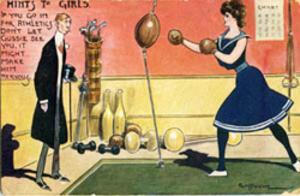More Memories from Jacalyn Blume
I knew Sally Fox only in the last couple of years of her life, as a neighbor, but mostly in connection with her placing her image collection at the Schlesinger Library, about which she felt very strongly. I met her at a get-together in our building. As soon as she learned that I worked at Schlesinger, a library and archives specializing in women's history at the Radcliffe Institute for Advanced Study at Harvard, where she had done research and which she had contacted about her collection of late 19th and early 20th century images of women at work and at play, Sally sat me down on the sofa and told me all about herself and her pictures. She was clearly passionate about this project, which she had built and researched and nurtured over three decades, a very personal extension of her professional work as a picture researcher.
This collection is not just a static group of pictures that Sally collected. She really saw herself as a teacher and a preserver and promoter of women's history. She wanted a home for her images where they would be understood for what they were, and where they would be accessible to scholars who could use them within the context of women's history. In spite of the ephemeral sources of the images she amassed, those in her personal collection, as well as those that she published in her books on "The Medieval Woman," "The Victorian Woman," and "The Sporting Woman" were not just pretty pictures or mere illustrations to be glanced over, but historical documents in their own rights, illuminating otherwise often un-documented aspects of women's lives.
Many of the images are posters, advertisements, magazine illustrations, or cigar box designs, but all of them show active women, engaged in real-life situations. The pictures show women participating in sports and working at jobs that fall both within the traditional pursuits of women, and well outside the realm of activities usually considered acceptable. Some images explicitly convey the notion of women advancing out of traditional spheres, such as a set of French postcards, ca. 1900, depicting a woman lawyer in the courtroom, caring for her child while arguing for a mother's right to work. Others are unexpected, such as the magazine feature showing women ice boating or photographs of women mountaineers, weighed down in Victorian dress but undaunted, and challenge our notions of what was appropriate for women merely by the fact of their unremarkable existence.
It is a terrific gift that her collection at the Schlesinger Library will preserve her passion and commitment to teaching with pictures and documenting women's lives.



